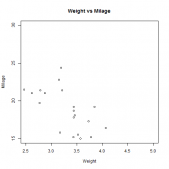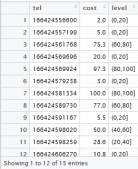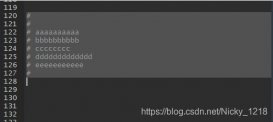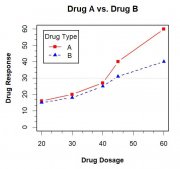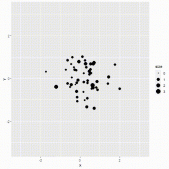1. 相关配置和说明
由于Dirk的书Seamless R and C++ Integration with Rcpp是13年出版的,当时Rcpp Attributes这一特性还没有被CRAN批准,所以当时调用和编写Rcpp函数还比较繁琐。Rcpp Attributes(2016)极大简化了这一过程(“provides an even more direct connection between C++ and R”),保留了内联函数,并提供了sourceCpp函数用于调用外部的.cpp文件。换句话说,我们可以将某C++函数存在某个.cpp文件中,再从R脚本文件中,像使用source一样,通过sourceCpp来调用此C++函数。
例如,在R脚本文件中,我们希望调用名叫test.cpp文件中的函数,我们可以采用如下操作:
|
1
2
3
|
library(Rcpp)Sys.setenv("PKG_CXXFLAGS"="-std=c++11")sourceCpp("test.cpp") |
其中第二行的意思是使用C++11的标准来编译文件。
在test.cpp文件中, 头文件使用Rcpp.h,需要输出到R中的函数放置在//[[Rcpp::export]]之后。如果要输出到R中的函数需要调用其他C++函数,可以将这些需要调用的函数放在//[[Rcpp::export]]之前。
|
1
2
3
|
#include <Rcpp.h>using namespace Rcpp;//[[Rcpp::export]] |
为进行代数计算,Rcpp提供了RcppArmadillo和RcppEigen。如果要使用此包,需要在函数文件开头注明依赖关系,例如// [[Rcpp::depends(RcppArmadillo)]],并载入相关头文件:
|
1
2
3
4
5
6
|
// [[Rcpp::depends(RcppArmadillo)]]#include <RcppArmadillo.h>#include <Rcpp.h>using namespace Rcpp;using namespace arma;// [[Rcpp::export]] |
C++的基本知识可以参见此处。
2. 常用数据类型
| 关键字 | 描述 |
|---|---|
| int/double/bool/String/auto | 整数型/数值型/布尔值/字符型/自动识别(C++11) |
| IntegerVector | 整型向量 |
| NumericVector | 数值型向量(元素的类型为double) |
| ComplexVector | 复数向量 Not Sure |
| LogicalVector | 逻辑型向量; R的逻辑型变量可以取三种值:TRUE, FALSE, NA; 而C++布尔值只有两个,true or false。如果将R的NA转化为C++中的布尔值,则会返回true。 |
| CharacterVector | 字符型向量 |
| ExpressionVector | vectors of expression types |
| RawVector | vectors of type raw |
| IntegerMatrix | 整型矩阵 |
| NumericMatrix | 数值型矩阵(元素的类型为double) |
| LogicalMatrix | 逻辑型矩阵 |
| CharacterMatrix | 字符矩阵 |
| List aka GenericVector | 列表;lists;类似于R中列表,其元素可以使任何数据类型 |
| DataFrame | 数据框;data frames;在Rcpp内部,数据框其实是通过列表实现的 |
| Function | 函数型 |
| Environment | 环境型;可用于引用R环境中的函数、其他R包中的函数、操作R环境中的变量 |
| RObject | 可以被R识别的类型 |
注释:
某些R对象可以通过as<Some_RcppObject>(Some_RObject)转化为转化为Rcpp对象。例如:
在R中拟合一个线性模型(其为List),并将其传入C++函数中
|
1
|
>mod=lm(Y~X); |
|
1
2
|
NumericVector resid = as<NumericVector>(mod["residuals"]);NumericVector fitted = as<NumericVector>(mod["fitted.values"]); |
可以通过as<some_STL_vector>(Some_RcppVector),将NumericVector转换为std::vector。例如:
|
1
2
|
std::vector<double> vec;vec = as<std::vector<double>>(x); |
在函数中,可以用wrap(),将std::vector转换为NumericVector。例如:
|
1
2
3
|
arma::vec long_vec(16,arma::fill::randn);vector<double> long_vec2 = conv_to<vector<double>>::from(long_vec);NumericVector output = wrap(long_vec2); |
在函数返回时,可以使用wrap(),将C++ STL类型转化为R可识别类型。示例见后面输入和输出示例部分。
以上数据类型除了Environment之外(Function不确定),大多可直接作为函数返回值,并被自动转化为R对象。
算数和逻辑运算符号+, -, *, /, ++, --, pow(x,p), <, <=, >, >=, ==, !=。逻辑关系符号&&, ||, !。
3. 常用数据类型的建立
|
1
2
3
4
5
6
7
8
9
10
11
12
13
14
15
16
17
18
19
20
21
22
|
//1. VectorNumericVector V1(n);//创立了一个长度为n的默认初始化的数值型向量V1。NumericVector V2=NumericVector::create(1, 2, 3); //创立了一个数值型向量V2,并初始化使其含有三个数1,2,3。LogicalVector V3=LogicalVector::create(true,false,R_NaN);//创立了一个逻辑型变量V3。如果将其转化为R Object,则其含有三个值TRUE, FALSE, NA。//2. MatrixNumericMatrix M1(nrow,ncol);//创立了一个nrow*ncol的默认初始化的数值型矩阵。//3. Multidimensional ArrayNumericVector out=NumericVector(Dimension(2,2,3));//创立了一个多维数组。然而我不知道有什么卵用。。//4. ListNumericMatrix y1(2,2);NumericVector y2(5);List L=List::create(Named("y1")=y1, Named("y2")=y2);//5. DataFrameNumericVector a=NumericVector::create(1,2,3);CharacterVector b=CharacterVector::create("a","b","c");std::vector<std::string> c(3);c[0]="A";c[1]="B";c[2]="C";DataFrame DF=DataFrame::create(Named("col1")=a, Named("col2")=b, Named("col3")=c); |
4. 常用数据类型元素访问
| 元素访问 | 描述 |
|---|---|
| [n] | 对于向量类型或者列表,访问第n个元素。对于矩阵类型,首先把矩阵的下一列接到上一列之下,从而构成一个长列向量,并访问第n个元素。不同于R,n从0开始。 |
| (i,j) | 对于矩阵类型,访问第(i,j)个元素。不同于R,i和j从0开始。不同于向量,此处用圆括号。 |
| List["name1"]/DataFrame["name2"] | 访问List中名为name1的元素/访问DataFrame中,名为name2的列。 |
5. 成员函数
| 成员函数 | 描述 |
|---|---|
| X.size() | 返回X的长度;适用于向量或者矩阵,如果是矩阵,则先向量化 |
| X.push_back(a) | 将a添加进X的末尾;适用于向量 |
| X.push_front(b) | 将b添加进X的开头;适用于向量 |
| X.ncol() | 返回X的列数 |
| X.nrow() | 返回X的行数 |
6. 语法糖
6.1 算术和逻辑运算符
+, -, *, /, pow(x,p), <, <=, >, >=, ==, !=, !
以上运算符均可向量化。
6.2. 常用函数
is.na()
Produces a logical sugar expression of the same length. Each element of the result expression evaluates to TRUE if the corresponding input is a missing value, or FALSE otherwise.
seq_len()
seq_len( 10 ) will generate an integer vector from 1 to 10 (Note: not from 0 to 9), which is very useful in conjugation withsapply() and lapply().
pmin(a,b) and pmax(a,b)
a and b are two vectors. pmin()(or pmax()) compares the i <script type="math/tex" id="MathJax-Element-1">i</script>th elements of a and b and return the smaller (larger) one.
ifelse()
ifelse( x > y, x+y, x-y ) means if x>y is true, then do the addition; otherwise do the subtraction.
sapply()
sapply applies a C++ function to each element of the given expression to create a new expression. The type of the resulting expression is deduced by the compiler from the result type of the function.
The function can be a free C++ function such as the overload generated by the template function below:
|
1
2
3
4
5
|
template <typename T>T square( const T& x){ return x * x ;}sapply( seq_len(10), square<int> ) ; |
Alternatively, the function can be a functor whose type has a nested type called result_type
|
1
2
3
4
5
6
7
|
template <typename T>struct square : std::unary_function<T,T> { T operator()(const T& x){ return x * x ; }}sapply( seq_len(10), square<int>() ) ; |
lappy()
lapply is similar to sapply except that the result is allways an list expression (an expression of type VECSXP).
sign()
其他函数
- 数学函数: abs(), acos(), asin(), atan(), beta(), ceil(), ceiling(), choose(), cos(), cosh(), digamma(), exp(), expm1(), factorial(), floor(), gamma(), lbeta(), lchoose(), lfactorial(), lgamma(), log(), log10(), log1p(), pentagamma(), psigamma(), round(), signif(), sin(), sinh(), sqrt(), tan(), tanh(), tetragamma(), trigamma(), trunc().
- 汇总函数: mean(), min(), max(), sum(), sd(), and (for vectors) var()
- 返回向量的汇总函数: cumsum(), diff(), pmin(), and pmax()
- 查找函数: match(), self_match(), which_max(), which_min()
- 重复值处理函数: duplicated(), unique()
7. STL
Rcpp可以使用C++的标准模板库STL中的数据结构和算法。Rcpp也可以使用Boost中的数据结构和算法。
7.1. 迭代器
此处仅仅以一个例子代替,详细参见C++ Primer,或者此处。
|
1
2
3
4
5
6
7
8
9
10
11
|
#include <Rcpp.h>using namespace Rcpp;// [[Rcpp::export]]double sum3(NumericVector x) { double total = 0; NumericVector::iterator it; for(it = x.begin(); it != x.end(); ++it) { total += *it; } return total;} |
7.2. 算法
头文件<algorithm>中提供了许多的算法(可以和迭代器共用),具体可以参见此处。
For example, we could write a basic Rcpp version of findInterval() that takes two arguments a vector of values and a vector of breaks, and locates the bin that each x falls into.
|
1
2
3
4
5
6
7
8
9
10
11
12
13
14
15
|
#include <algorithm>#include <Rcpp.h>using namespace Rcpp;// [[Rcpp::export]]IntegerVector findInterval2(NumericVector x, NumericVector breaks) { IntegerVector out(x.size()); NumericVector::iterator it, pos; IntegerVector::iterator out_it; for(it = x.begin(), out_it = out.begin(); it != x.end(); ++it, ++out_it) { pos = std::upper_bound(breaks.begin(), breaks.end(), *it); *out_it = std::distance(breaks.begin(), pos); } return out;} |
7.3. 数据结构
STL所提供的数据结构也是可以使用的,Rcpp知道如何将STL的数据结构转换成R的数据结构,所以可以从函数中直接返回他们,而不需要自己进行转换。
具体请参考此处。
7.3.1. Vectors
详细信息请参见处此
创建
vector<int>, vector<bool>, vector<double>, vector<String>
元素访问
利用标准的[]符号访问元素
元素增加
利用.push_back()增加元素。
存储空间分配
如果事先知道向量长度,可用.reserve()分配足够的存储空间。
例子:
The following code implements run length encoding (rle()). It produces two vectors of output: a vector of values, and a vector lengths giving how many times each element is repeated. It works by looping through the input vector x comparing each value to the previous: if it's the same, then it increments the last value in lengths; if it's different, it adds the value to the end of values, and sets the corresponding length to 1.
|
1
2
3
4
5
6
7
8
9
10
11
12
13
14
15
16
17
18
19
20
21
22
23
24
25
26
27
28
29
30
31
|
#include <Rcpp.h>using namespace Rcpp;// [[Rcpp::export]]List rleC(NumericVector x) { std::vector<int> lengths; std::vector<double> values; // Initialise first value int i = 0; double prev = x[0]; values.push_back(prev); lengths.push_back(1); NumericVector::iterator it; for(it = x.begin() + 1; it != x.end(); ++it) { if (prev == *it) { lengths[i]++; } else { values.push_back(*it); lengths.push_back(1); i++; prev = *it; } } return List::create( _["lengths"] = lengths, _["values"] = values );} |
7.3.2. Sets
STL中的集合std::set不允许元素重复,而std::multiset允许元素重复。集合对于检测重复和确定不重复的元素具有重要意义((like unique, duplicated, or in))。
Ordered set: std::set和std::multiset。
Unordered set: std::unordered_set
一般而言unordered set比较快,因为它们使用的是hash table而不是tree的方法。
unordered_set<int>, unordered_set<bool>, etc
7.3.3. Maps
与table()和match()关系密切。
Ordered map: std::map
Unordered map: std::unordered_map
Since maps have a value and a key, you need to specify both types when initialising a map:
map<double, int>, unordered_map<int, double>.
8. 与R环境的互动
通过EnvironmentRcpp可以获取当前R全局环境(Global Environment)中的变量和载入的函数,并可以对全局环境中的变量进行修改。我们也可以通过Environment获取其他R包中的函数,并在Rcpp中使用。
获取其他R包中的函数
|
1
2
3
|
Rcpp::Environment stats("package:stats");Rcpp::Function rnorm = stats["rnorm"];return rnorm(10, Rcpp::Named("sd", 100.0)); |
获取R全局环境中的变量并进行更改
假设R全局环境中有一个向量x=c(1,2,3),我们希望在Rcpp中改变它的值。
|
1
2
3
4
|
Rcpp::Environment global = Rcpp::Environment::global_env();//获取全局环境并赋值给Environment型变量globalRcpp::NumericVector tmp = global["x"];//获取xtmp=pow(tmp,2);//平方global["x"]=tmp;//将新的值赋予到全局环境中的x |
获取R全局环境中的载入的函数
假设全局环境中有R函数funR,其定义为:
|
1
2
3
4
|
x=c(1,2,3);funR<-function(x){ return (-x);} |
并有R变量x=c(1,2,3)。我们希望在Rcpp中调用此函数并应用在向量x上。
|
1
2
3
4
5
6
7
8
9
10
|
#include <Rcpp.h>using namespace Rcpp;// [[Rcpp::export]]NumericVector funC() { Rcpp::Environment global = Rcpp::Environment::global_env(); Rcpp::Function funRinC = global["funR"]; Rcpp::NumericVector tmp = global["x"]; return funRinC(tmp);} |
9. 用Rcpp创建R包
见此文
10. 输入和输出示例
如何传递数组
如果要传递高维数组,可以将其存为向量,并附上维数信息。有两种方式:
通过.attr("dim")设置维数
NumericVector可以包含维数信息。数组可以用过NumericVector输出到R中。此NumericVector可以通过.attr(“dim”)设置其维数信息。
|
1
2
3
4
5
|
// Dimension最多设置三个维数output.attr("dim") = Dimension(3,4,2);// 可以给.attr(“dim”)赋予一个向量,则可以设置超过三个维数NumericVector dim = NumericVector::create(2,2,2,2);output.attr("dim") = dim; |
示例:
|
1
2
3
4
5
6
7
8
9
10
11
12
13
14
15
16
17
18
19
|
// 返回一个3*3*2数组RObject func(){ arma::vec long_vec(18,arma::fill::randn); vector<double> long_vec2 = conv_to<vector<double>>::from(long_vec); NumericVector output = wrap(long_vec2); output.attr("dim")=Dimension(3,3,2); return wrap(output);}// 返回一个2*2*2*2数组 // 注意con_to<>::from()RObject func(){ arma::vec long_vec(16,arma::fill::randn); vector<double> long_vec2 = conv_to<vector<double>>::from(long_vec); NumericVector output = wrap(long_vec2); NumericVector dim = NumericVector::create(2,2,2,2); output.attr("dim")=dim; return wrap(output);} |
另外建立一个向量存维数,在R中再通过.attr("dim")设置维数
函数返回一维STL vector
自动转化为R中的向量
|
1
2
3
4
5
6
7
8
9
10
11
12
13
14
15
|
vector<double> func(NumericVector x){ vector<double> vec; vec = as<vector<double>>(x); return vec;}NumericVector func(NumericVector x){ vector<double> vec; vec = as<vector<double>>(x); return wrap(vec);}RObject func(NumericVector x){ vector<double> vec; vec = as<vector<double>>(x); return wrap(vec);} |
函数返回二维STL vector
自动转化为R中的list,list中的每个元素是一个vector。
|
1
2
3
4
5
6
7
8
9
10
11
12
13
14
|
vector<vector<double>> func(NumericVector x) { vector<vector<double>> mat; for (int i=0;i!=3;++i){ mat.push_back(as<vector<double>>(x)); } return mat;}RObject func(NumericVector x) { vector<vector<double>> mat; for (int i=0;i!=3;++i){ mat.push_back(as<vector<double> >(x)); } return wrap(mat);} |
返回Armadillo matrix, Cube 或 field
自动转化为R中的matrix
|
1
2
3
4
5
6
7
8
|
NumericMatrix func(){ arma::mat A(3,4,arma::fill::randu); return wrap(A);}arma::mat func(){ arma::mat A(3,4,arma::fill::randu); return A;} |
自动转化为R中的三维array
|
1
2
3
4
5
6
7
8
|
arma::cube func(){ arma::cube A(3,4,5,arma::fill::randu); return A;}RObject func(){ arma::cube A(3,4,5,arma::fill::randu); return wrap(A);} |
自动转化为R list,每个元素存储一个R向量,但此向量有维数信息(通过.Internal(inspect())查询)。
|
1
2
3
4
5
6
7
8
|
RObject func() { arma::cube A(3,4,2,arma::fill::randu); arma::cube B(3,4,2,arma::fill::randu); arma::field <arma::cube> F(2,1); F(0)=A; F(1)=B; return wrap(F);} |
参考文献:
Eddelbuettel, D. (2013). Seamless R and C++ Integration with Rcpp. Springer Publishing Company, Incorporated. ·
Allaire, J.J. (2016). Rcpp Attributes.
Eddelbuettel, D. (2016). Rcpp syntactic sugar.
http://adv-r.had.co.nz/Rcpp.html
http://blog.csdn.net/a358463121
http://www.runoob.com/cplusplus/cpp-operators.html
如需引用,请注明出处。
以上就是R语言学习Rcpp知识全面整理的详细内容,更多关于Rcpp知识全面整理的资料请关注服务器之家其它相关文章!
原文链接:https://blog.csdn.net/iamsuperman2/article/details/73251928


